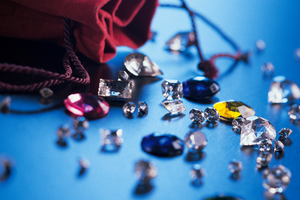Precious stones have fascinated people for decades. They used to serve as a means of payment or a part of ornaments worn by the wealthiest social classes. In the 21st century, they are still as popular as before. How to recognise precious stones? Here are 4 proven methods!

How to check if the stone is genuine? Method 1: ask a gemmologist
The average consumer knows little about precious stones. A layperson is unable to differentiate coloured glass from a ruby, or a zirconia from a diamond. How to estimate the value and grade of a stone? When we need the valuation and opinion of an expert, it is best to directly consult a gemmological laboratory. (A gemmologist is a specialist in recognising minerals, who has advanced knowledge and tools that allow them to determine the type and value of a stone).
A gemmological opinion is without a doubt the best way to recognise a genuine precious stone. We should also note that not every jeweller is a gemmologist. So if we wish to obtain a reliable valuation based on expertise, it’s best to not rely on a cursory examination carried out at a jeweller’s shop. A gemmologist will thoroughly analyse the stone using an array of instruments and tools such as professional magnifiers, jeweller’s sclerometers, microscopes and sets of test precious stones.
How to check what stone we have in our ring? Method 2: analysing colour and light
When we find a beautiful mineral lying on the ground, or receive a colourful pendant as a gift, we often wonder how to recognise which stone it is and how much it is worth. We can carry out a simple test at home that allows us to learn more about its authenticity and value. With a magnifying glass, or a loupe if one is available, we can check the stone’s colour and how sunlight or artificial light passes through it.
A precious stone usually has a very intense colour and a high refractive index. How to recognise a stone in a ring? A natural mineral rarely has an ideal, uniform, perfect colour. The light that goes through a precious stone splits, and it may flicker, or create a glow, or diffract – i.e., scatter, or disperse – the colour. Artificial stones or zirconias are distinguished by the fact that sunlight passes through them easily. The colour of imitation minerals is often uniform, with no cloudy trails, inclusions (particles of other crystals), cracks, or bubbles.
Method 3: a home-made heat test – a method to differentiate brilliants from synthetics
There are a few ways to recognise precious stones, when we have no magnifying glass or other tools. One of the simplest methods to distinguish a diamond from glass and crystal is the temperature (heat) test. How to carry it out? Just expose the stone to sunlight or place it under a flow of hot tap water. You can also heat it up with hot air from a hand-held hair dryer. The heat will make artificial materials warm up, while a diamond will keep its constant temperature.
Method 4: hardness test – to recognise a precious stone
How to check if a precious stone is authentic? We should remember that each mineral has a particular hardness. That parameter is defined by the ten-degree Mohs scale, which puts the diamond in 10th position, the highest, as the hardest stone. So if we want to check whether the stone is authentic, we can just try to scratch it with another stone positioned lower on the Mohs scale. Diamonds cannot be scratched with any other mineral, and not even with a steel device.
The hardness of the ruby, emerald or other precious stones can be determined with the use of the Mohs scale and a manual tester. Such measuring instruments, available in online stores, indicate the hardness of minerals in the range of 1 to 10. However, non-professional tools tend to become decalibrated, so the test result is often unreliable. If we want to thoroughly analyse the mineral’s hardness and features, we should consult a gemmologist. The specialist will use a spectrometer and precisely determine the value of the stone.
